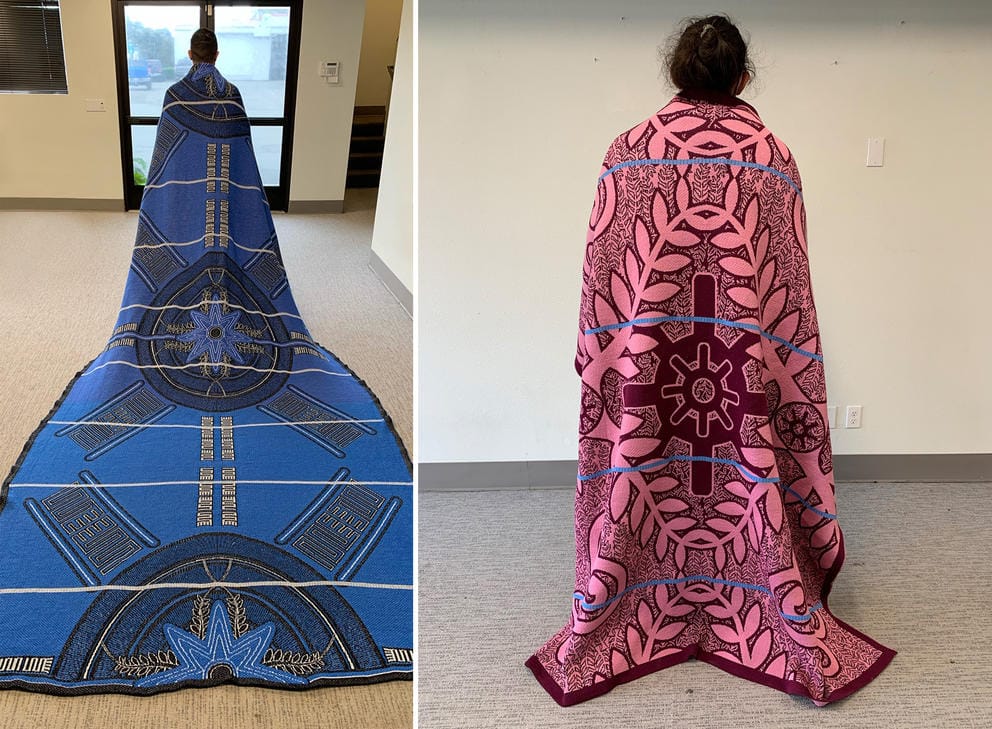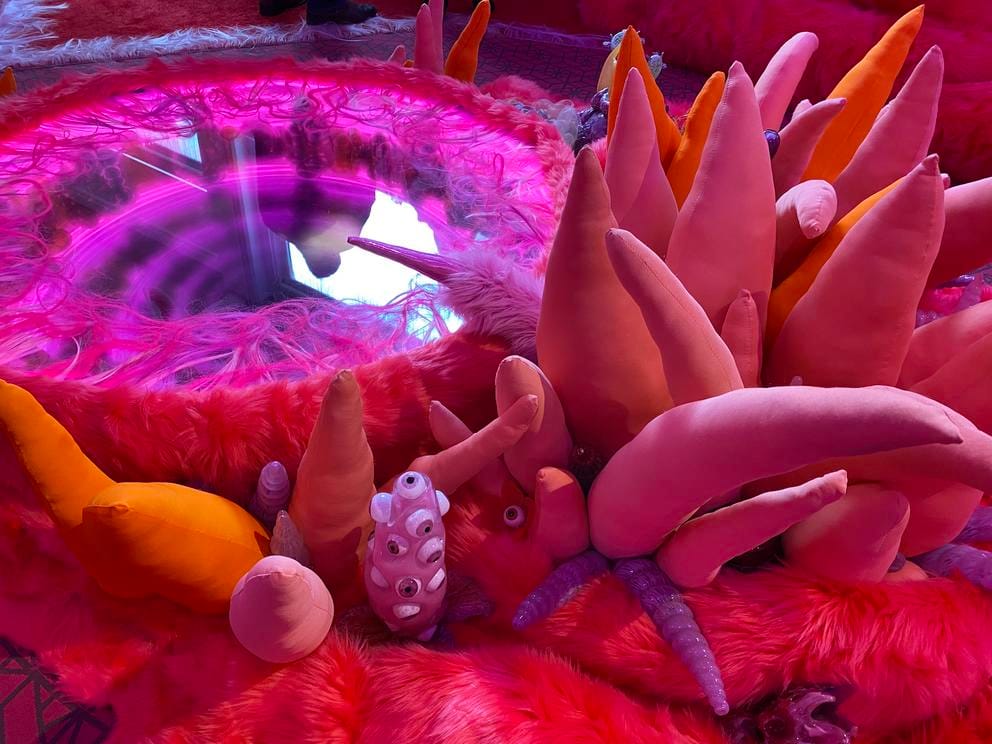If you’ve seen Marvel’s Black Panther movies — or even just the trailers — you know the costuming is out of this world. That’s thanks to genius designer Ruth Carter, who won Best Costume Design for Black Panther at the 2019 Academy Awards.
She’s up for the same award at the Oscars this weekend (March 12, 5 p.m.), for her work in the sequel Black Panther: Wakanda Forever. And this time, part of her Afrofuturistic vision includes blankets made in Seattle by Native-owned Indigenous design and retail business Eighth Generation.
ArtSEA: Notes on Northwest Culture is Crosscut’s weekly arts & culture newsletter.
In Black Panther, Wakanda leaders are adorned in luxurious blankets with geometric patterns inspired by real-world Basotho heritage blankets. (Carter asked permission from the Basotho people in South Africa to replicate the distinctive stripes). At Eighth Generation, Native-designed blankets have long been a staple of the Pike Place Market store’s offerings.
In a fortuitous series of connections, which Eighth Generation founder Louie Gong outlined on Instagram, Marvel reached out to the company in 2020 to create a new series of blankets for Wakanda Forever — a huge opportunity for the small local business.

At left, Eighth Generation founder Louie Gong models one of the blankets his Seattle company created for use in the movie ‘Black Panther: Wakanda Forever.’ At right, Eighth Generation warehouse manager Eric Alipio models another Wakanda blanket made on the knitting machines in SoDo. (Eighth Generation)
I recently spoke with Kim Kroeker, director of product development at Eighth Generation, about her role in bringing the blankets to life. Kroeker programmed Ruth Carter’s detailed digital designs into a high-tech knitting machine housed in Eighth Generation’s SoDo facility. She also did extensive testing to make sure all the blanket designs and colors had the Black Panther look and feel.
How were the blankets conceived?
Marvel came to us with designs created by Ruth [Carter] and her team. She wanted to convey a traditional African design with a technological look — almost like a circuit board. We worked with the team and had to adapt designs based on the knitting technology and what our machines can do.
Had you made anything like this before?
When we took on the project in 2020, we had just recently purchased the machine — and had only created scarves and baby blankets so far. This project forced us to figure out how to use the machines for large blankets — we had to innovate.
Was there much trial and error?
Yes, we did so much sampling to nail down the look and the weight! These are thick, very warm blankets — six pounds per blanket, which is basically a “weighted blanket.” For the longer blankets in the movie, we had to use a lighter weight because it would be way too heavy for the actors to move around.
Did the experience influence your Eighth Generation blankets?
We aren’t selling the Wakanda designs, but the aesthetic we developed is something we’re now using for our own Gold Label line of blankets. Marvel really helped us dial in what we wanted to produce. We’ll have a new limited edition blanket coming out in the fall.
Who do you think should win the Oscar for Best Costume Design?
Ruth Carter, of course! She designed a whole world. Her stuff is iconic.
If you choose to tune in and root for Ruth, remember that the Oscars ceremony started as a radio broadcast — and a librarian from Yakima was instrumental in bringing the show to television. (Learn the history in my 2019 story about UW grad turned Academy of Motion Picture Arts and Sciences leader Margaret Herrick.)

“Delectable,” by Bri Chesler and Minhi England, is a full-room installation at Method Gallery. (Brangien Davis/Crosscut)
Mushroom mania
According to some sources, Washington is the state “3rd most obsessed” with the HBO Max television series The Last of Us. This news comes courtesy of a dubious press release touting research conducted by something called SolitaireGaming.com. (I get a lot of odd press releases.)
Based on a survey of Google search terms, Washingtonians are allegedly more interested in the zombie apocalypse show than people in every other state except New York and Massachusetts.
I cannot confirm or deny this contention, but I’m afraid I might be somewhat obsessed with the show myself, since when I went art-walking this past weekend I found myself seeing mushrooms, spores and fungi everywhere.
For those not watching: The Last of Us, whose season finale is this weekend (March 12), presents a future in which a Cordyceps fungus runs amok among us. Infected people turn into hideous human-shrooms. Thankfully I didn’t run into any of those. But I did encounter some delightful mycelium moments.

Pieces of "The Passage" by Seattle ceramicist Jodi Rockwell at Koplin Del Rio gallery. (Brangien Davis/Crosscut)
For example: a new immersive creation by Northwest art duo Bri Chesler and Minhi England. Called Delectable (through April 15 at Method Gallery), this glowing fuchsia jungle of bubbling blown glass and sewn fabric extrusions features endless nooks and crannies hiding spooky surprises.
The elaborate installation includes neon sculpture, thick pink fur, mirrors, eyeballs, tongues and other body parts that aren’t where they should be. “Corporeal representations appear alien and unusual,” reads the artists’ statement, “revealing the transcendence of beauty into something much more freakish.” Indeed.
Nearby, at Shift Gallery, Portland artist Amanda Triplett’s Nature Nurture (through April 1) reveals strips of recycled fabrics sewn into wall sculptures in greens and yellows. The feeling is one of cells reproducing organically, and perhaps out of control. And at Fruitsuper studio and shop, the excellent group show Findings (through April 6) includes artist Amanda Woodcock’s “Wallflowers,” green stoneware globs out of which grow glass flora and fungi.
Further south, in Georgetown, do not miss the new ceramics show by Seattle artist Jodi Rockwell. The Passage (at Koplin Del Rio through April 15) takes visitors on what Rockwell calls a Jungian voyage through the self — starting with the sleek, tidy forms in the gallery windows, then diving ever deeper into the messiness within us.
Many of Rockwell’s forms are soft, shroomy or seedlike shapes — others burble with barnacles and gnarly black extrusions. But don’t worry, you end up in a peaceful-pink (and zombie-free) zone.
Fond farewell
One final note: This week we bid adieu to Crosscut reporter Margo Vansynghel. A stellar reporter and a staunch believer in the importance of arts and culture coverage, Margo wrote everything from a funny look at Seattle’s Selfie Museum to this week’s deeply researched investigation into a possible forgery of Northwest painter Alden Mason’s work. (She also took the ArtSEA helm whenever I was absent.) Margo will be missed as she moves on to artful new endeavors!



